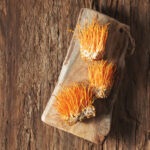Power up your immune system with THIS unique fungus
 (NaturalHealth365) At first glance, the following scenario seems straight out of a horror movie. A parasitic fungus infests, feeds off, and ultimately kills its host – then erupts out of the corpse’s shell through a “fruiting body.” Could anything be more grotesque?
(NaturalHealth365) At first glance, the following scenario seems straight out of a horror movie. A parasitic fungus infests, feeds off, and ultimately kills its host – then erupts out of the corpse’s shell through a “fruiting body.” Could anything be more grotesque?
Yet the product of this gruesome episode (the fruiting body, commonly known as cordyceps) offers nutritional and medicinal benefits galore, making cordyceps a sought-after natural remedy. Revered in traditional Chinese medicine (TCM) for its antiaging benefits, cordyceps is also receiving validation from the scientific community. In a new study published in Scientific Reports, researchers concluded that this mysterious fungus can stimulate the immune system.
Cordyceps enhances the activity of infection-fighting white blood cells
To conduct the study, researchers investigated the effects of cordycepin – the active constituent of cordyceps – on 40 healthy adults. Participants were given either 2.85 mg of cordycepin or a placebo daily for eight weeks.
The scientists found that the cordycepin group displayed increased activity of NK (natural killer) cells – white blood cells that destroy infected and diseased cells. Interestingly, while both genders experienced increases, effects were more pronounced in male volunteers.
In addition, cordycepin increased levels of interferon – a protein that defends against viral infection – while reducing levels of pro-inflammatory cytokines. The researchers deemed cordyceps a new “alternative natural immunostimulatory supplement.”
The scientists’ findings mirrored the results of an earlier Korean study published in the Journal of Medicinal Foods, in which 1.5 g a day of Cordyceps militaris boosted levels of NK cells. And that isn’t all.
Some researchers believe that cordyceps – besides being antioxidant, antidiabetic, neuroprotective, antiaging, anticancer, and immunomodulatory – may help alleviate lung problems. Studies have shown that this unique fungus acts against lung inflammation and allergic asthma by suppressing inflammatory cytokines and immunoglobulin E. Finally, research suggests that polysaccharides found in the fungus can help combat obesity.
That’s quite a menu of potential benefits!
Sharpen athletic performance and pump up energy levels
In a three-week study, participants performing high-intensity exercise were given a daily mushroom blend containing Cordyceps. They displayed significant improvement in VO2 max, which involves oxygen absorption while exercising.
Cordyceps may also help increase the body’s production of ATP (adenosine triphosphate), also known as the “energy molecule.” Yet another study showed that combining cordyceps sinensis and rhodiola improved aerobic performance during high-altitude climbing.
But you don’t need to be a mountaineer or marathon runner to see benefits. Holistic health practitioners sometimes advise a combination of cordyceps, rhodiola, and ginseng to combat everyday fatigue. Finally, cordyceps is believed to promote a healthy libido, giving rise to its nickname of “Himalayan Viagra.”
“A tale of two fungi” – there is an alternative to exorbitantly-priced C. sinensis
Cordyceps sinensis, or Dong Chong Xia Cao, is the “original” remedy with the longest history of use. Because it is found only on the caterpillars of a specific type of moth from the Himalayan mountains, C. sinensis is both scarce and expensive. Its many constituents include polysaccharides, cordycepin, cordycepic acid, beta-sitosterol, and vitamins E, K, B2, and B12, and potassium, calcium, magnesium, iron, zinc, and selenium.
The good news is that C. sinensis can now be successfully cultivated. This form, C. militaris, is grown in a lab using rice and possesses benefits and properties similar to C. sinensis.
According to research published in Critical Reviews in Biotechnology, both forms of the fungi have identical chemical components. In addition to being much more affordable, C. militaris has less chance of contamination with harmful heavy metals, and it helps protect limited natural resources. There is one other small difference – unlike C. sinensis, which can be eaten uncooked, raw C. militaris must be cooked before eating to protect against possible digestive upset.
Consider cooking with cordyceps
Cordyceps has a mild, nutty, earthy flavor. The C. sinensis variety can be eaten uncooked, ground down, cooked, or baked into foods such as pasta, quinoa, breads, and soups. If eating the fungus isn’t your “thing,” it is available as a supplement. Look for a high-quality product from a reputable vendor, one labeled either Cordyceps sinensis or Cordyceps militaris.
Holistic healthcare providers typically recommend one to four grams of cordyceps daily. Before trying it, check with your holistic physician to see if this intriguing fungus is right for you.
For many, cordyceps has an undeniable creepy aspect. But this shape-shifting “body snatcher” is actually nutritious and beneficial, rapidly emerging as an important functional food and supplement.
Sources for this article include:
Nature.com
Clevelandclinic.org
NIH.gov
NIH.gov
Healthline.com



